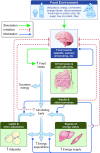The energy balance model of obesity: beyond calories in, calories out
- PMID: 35134825
- PMCID: PMC9071483
- DOI: 10.1093/ajcn/nqac031
The energy balance model of obesity: beyond calories in, calories out
Abstract
A recent Perspective article described the "carbohydrate-insulin model (CIM)" of obesity, asserting that it "better reflects knowledge on the biology of weight control" as compared with what was described as the "dominant energy balance model (EBM)," which fails to consider "biological mechanisms that promote weight gain." Unfortunately, the Perspective conflated and confused the principle of energy balance, a law of physics that is agnostic as to obesity mechanisms, with the EBM as a theoretical model of obesity that is firmly based on biology. In doing so, the authors presented a false choice between the CIM and a caricature of the EBM that does not reflect modern obesity science. Here, we present a more accurate description of the EBM where the brain is the primary organ responsible for body weight regulation operating mainly below our conscious awareness via complex endocrine, metabolic, and nervous system signals to control food intake in response to the body's dynamic energy needs as well as environmental influences. We also describe the recent history of the CIM and show how the latest "most comprehensive formulation" abandons a formerly central feature that required fat accumulation in adipose tissue to be the primary driver of positive energy balance. As such, the new CIM can be considered a special case of the more comprehensive EBM but with a narrower focus on diets high in glycemic load as the primary factor responsible for common obesity. We review data from a wide variety of studies that address the validity of each model and demonstrate that the EBM is a more robust theory of obesity than the CIM.
Keywords: carbohydrates; energy balance; food intake; insulin; obesity.
Published by Oxford University Press on behalf of the American Society for Nutrition 2022.
Figures

Comment in
-
Clarification on our critique of the energy balance hypothesis of obesity.Am J Clin Nutr. 2022 Aug 4;116(2):610-611. doi: 10.1093/ajcn/nqac160. Am J Clin Nutr. 2022. PMID: 35675213 No abstract available.
-
Leaving energy balance behind.Am J Clin Nutr. 2022 Aug 4;116(2):611-612. doi: 10.1093/ajcn/nqac161. Am J Clin Nutr. 2022. PMID: 35675223 No abstract available.
-
The energy balance model compared with the carbohydrate-insulin model.Am J Clin Nutr. 2022 Aug 4;116(2):612-614. doi: 10.1093/ajcn/nqac162. Am J Clin Nutr. 2022. PMID: 35675308 No abstract available.
References
Publication types
MeSH terms
Substances
Grants and funding
LinkOut - more resources
Full Text Sources
Medical
Research Materials

